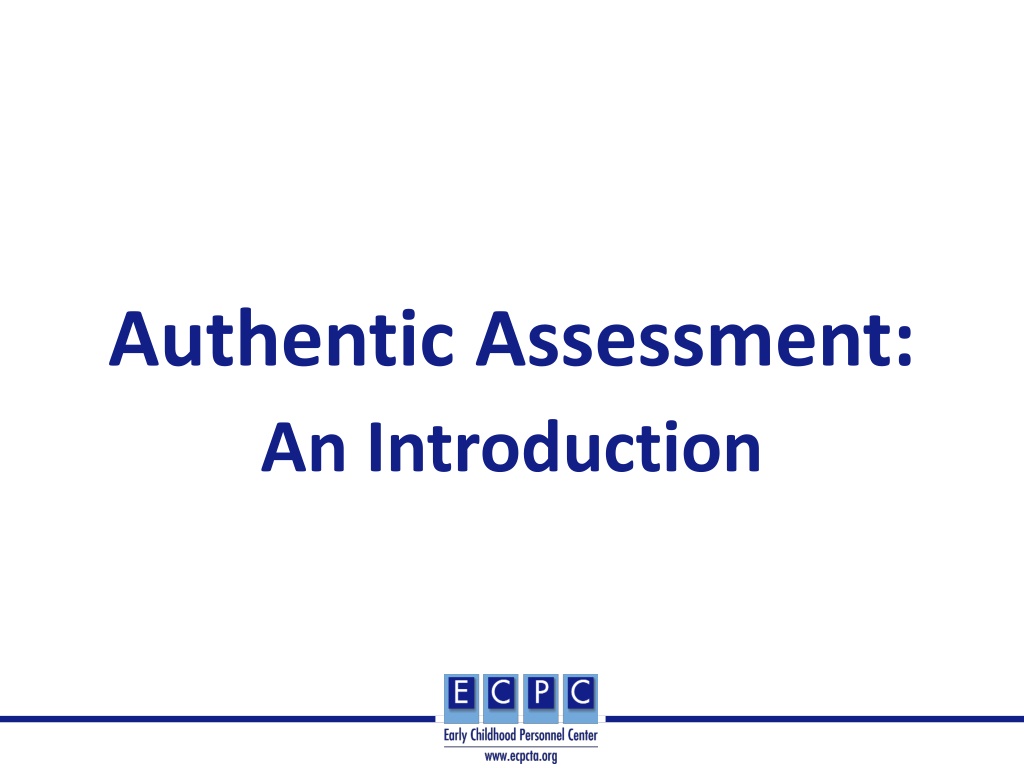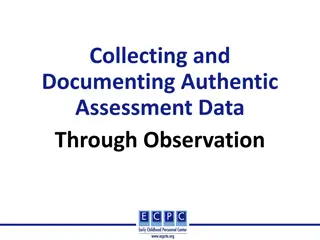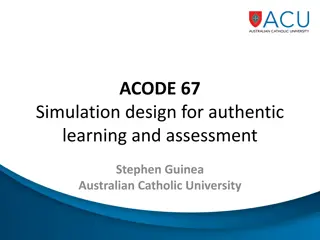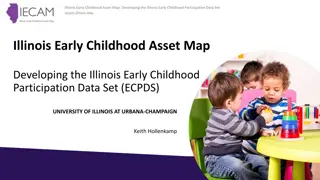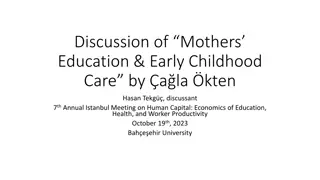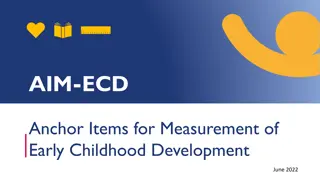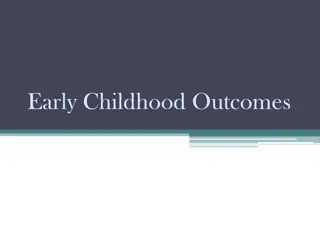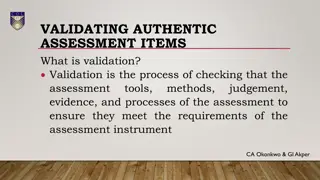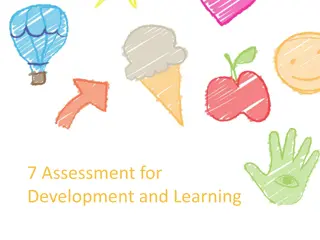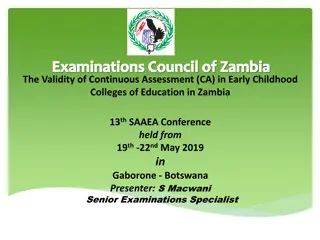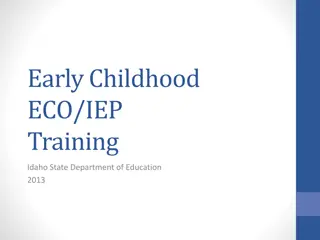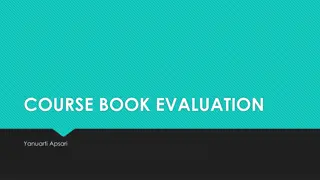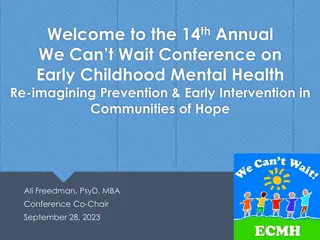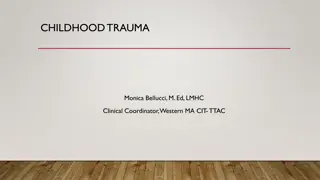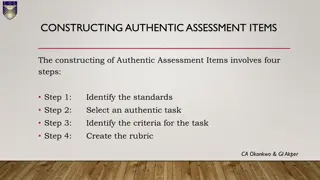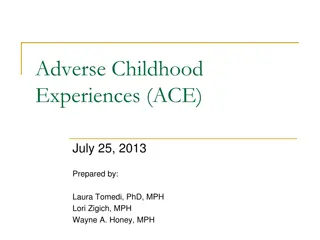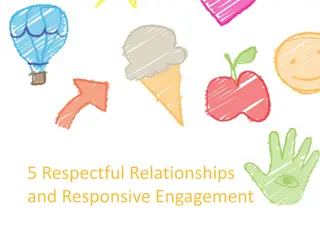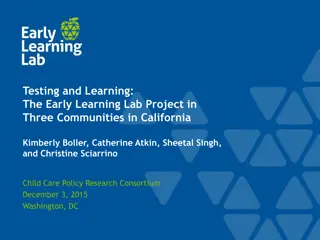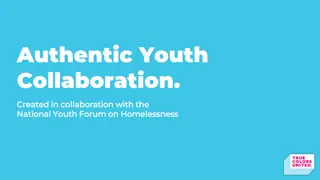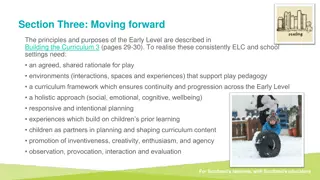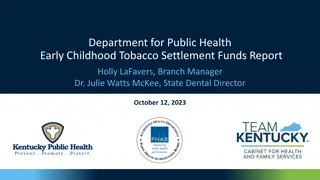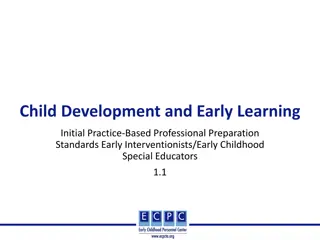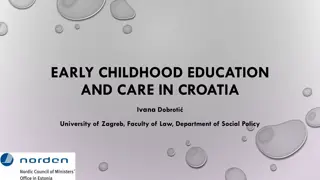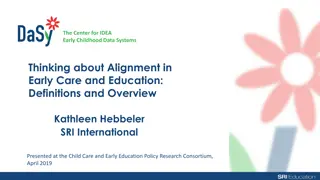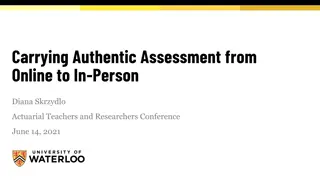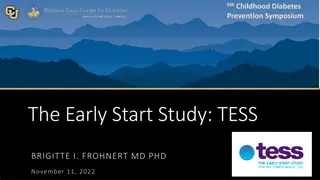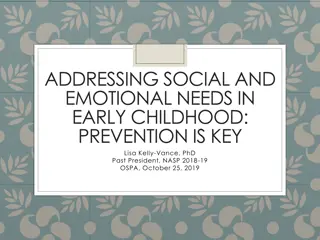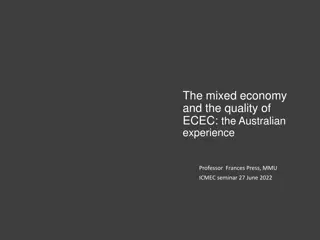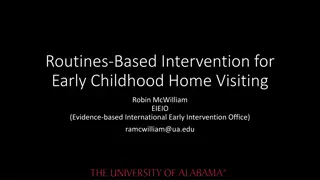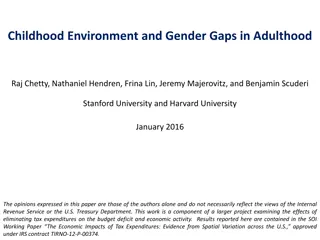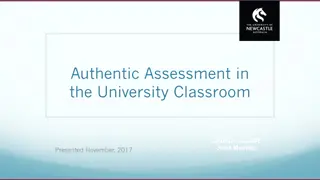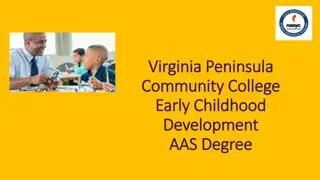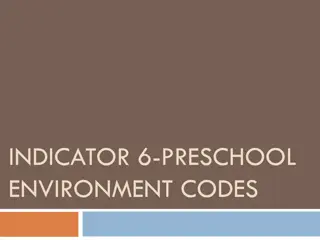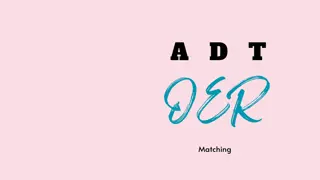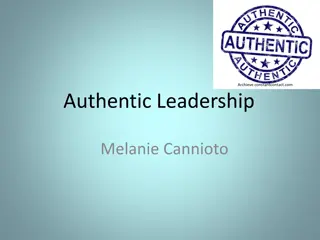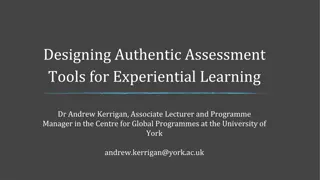Comprehensive Guide to Authentic Assessment in Early Childhood Education
This comprehensive guide delves into the importance of authentic assessment in early childhood education, focusing on key standards and recommended practices. It covers the development and administration of assessments, collaboration with families, utilizing evidence-based practices, and monitoring progress effectively. With a strong emphasis on gathering information from multiple sources and adapting to children's diverse needs, this guide serves as a valuable resource for educators and professionals in the field.
Download Presentation

Please find below an Image/Link to download the presentation.
The content on the website is provided AS IS for your information and personal use only. It may not be sold, licensed, or shared on other websites without obtaining consent from the author. Download presentation by click this link. If you encounter any issues during the download, it is possible that the publisher has removed the file from their server.
E N D
Presentation Transcript
Authentic Assessment: An Introduction
EI/ECSE Standard 4, Component 4.2 Candidates develop and administer informal assessments and/or select and use valid, reliable formal assessments using evidence- based practices, including technology, in partnership with families and other professionals.
EI/ECSE Standard 4, Component 4.4 Candidates, in collaboration with families and other team members, use assessment data to determine eligibility, develop child and family- based outcomes/goals, plan for interventions and instruction, and monitor progress to determine the efficacy of programming.
DEC Recommended Practices (RPs, 2014) A1 Practitioners work with the family to identify family preferences for assessment processes. A2 Practitioners work as a team with the family and other professionals to gather assessment information. A3 Practitioners use assessment materials and strategies that are appropriate for the child s age and level of development and accommodate the child s sensory, physical, communication, cultural, linguistic, social, and emotional characteristics.
DEC RPs (2014) A4 Practitioners conduct assessments that include all areas of development and behavior to learn about the child s strengths, needs, preferences, and interests. A5 Practitioners conduct assessments in the child s dominant language and in additional languages if the child is learning more than one language. A6 Practitioners use a variety of methods, including observation and interviews, to gather assessment information from multiple sources, including the child s family and other significant individuals in the child s life.
More DEC RPs (2014) A7 Practitioners obtain information about the child s skills in daily activities, routines, and environments such as home, center, and community. A8 Practitioners use clinical reasoning in addition to assessment results to identify the child s current levels of functioning and to determine the child s eligibility and plan for instruction. A9 Practitioners implement systematic ongoing assessment to identify learning targets, plan activities, and monitor the child s progress to revise instruction as needed.
And More DEC RPs (2014) A10 Practitioners use assessment tools with sufficient sensitivity to detect child progress, especially for the child with significant support needs. A11 Practitioners report assessment results so that they are understandable and useful to families.
Objectives Authentic assessment, its purpose, and its characteristics. Describe Authentic assessment measures and their uses. Identify Identify and describe Strategies to involve families in authentic assessment, inclusive of culturally and linguistically responsive strategies.
Authentic Assessment Definition the systematic recording of developmental observations over time about the naturally occurring behaviors and functional competencies of young children in daily routines by familiar and knowledgeable caregivers in the child s life. Bagnato, S. J., & Yeh-Ho, H. (2006)
Five Characteristics of Authentic Assessment Ongoing Useful Holistic Naturalistic Collaborative
How Authentic Assessment Fits in the Assessment Process Screening Diagnosis/eligibility Program planning Progress monitoring Program evaluation/accountability
Authentic Assessment Cycle Observation Intervention & Instruction Documentation Review & Interpretation Planning
Comparison of Authentic Assessment With Formal Assessment Formal Authentic Child selects a response Recall/recognition Setting unfamiliar Person(s) administering unfamiliar Contrived Child performs a task Application of skills Setting familiar Person administering familiar Real-life
Authentic Assessment Measures
Commonly Used Authentic Assessment Measures Criterion-referenced Curriculum-based Play-based Interviews Checklists Rubrics Work samples Portfolios Anecdotal notes Event sampling Duration recording Interval recording Latency
Questions to Consider in Selecting an Authentic Assessment Measure Who is to be assessed? What behavior(s) or skill(s) are to be assessed? What is the best assessment measure for those behavior(s) or skill(s)? Who will conduct the assessment and when? What training is needed to use that measure? What materials, etc. are needed? How will the results be summarized, interpreted and used?
Criterion-Referenced Assessments Measure an individual child s performance against a predetermined set of criteria, typically developmentally sequenced or task analyzed skills.
Characteristics of Criterion- Referenced Assessments May be standardized, yet, Allow for flexibility in administration procedures, Provide for comparison of a child s performance with their past performance, Emphasize behaviors/skills mastered by the child, and Provide formative information. Purpose with Passion Purpose with Passion
Curriculum-Based Assessment (CBA) Measures that assess a child s performance on a continuum of functional skills within a developmentally sequenced curriculum organized by developmental or content domains. Also referred to as Curriculum-Referenced. Purpose with Passion Purpose with Passion
Using CBAs Link assessment, intervention and instruction, and evaluation by: Assessing the child to determine what to teach, Planning for intervention and instruction, Implementing intervention and instruction, and Reassessing the child on a continuous basis to identify the child s progress. Purpose with Passion Purpose with Passion
Discussion/Reflection What criterion-referenced or curriculum- based assessment have you used or observed being used? What was the purpose of the assessment? How were the results of the assessment used? Purpose with Passion Purpose with Passion
Play-Based Assessment Assesses the child s development in all developmental domains and occurs in the child s natural environment with the facilitator following the child s lead and facilitating the child s play. Purpose with Passion Purpose with Passion
Benefits of Play-Based Assessment Results in a holistic view of the child across all developmental domains, Allows for observation of the child in a familiar, natural environment, Includes opportunities to observe interactions with the environment, parents, other caregivers, and/or peers, and Facilitates observation of children from diverse cultural backgrounds. Purpose with Passion Purpose with Passion
Play-Based Assessment (5:59) Watch the video and listen/watch for the following: What happens with the child during play- based assessment? What is assessed? What are the roles of the family in planning for and participating in the play-based assessment? What professionals are involved and what are their roles? Purpose with Passion Purpose with Passion
Involving Families in the Authentic Assessment Process Purpose with Passion Purpose with Passion
Engaging Families as Assessment Partners Practice Guide Read the Families and Their Child s Assessment section of the practice guide. Think about assessment practices in your current work or field placement setting and respond to the following: oWhich practices are currently being used? oWhat could your program do differently to more actively involve families? oWhat additional practices would you add to this guide? Purpose with Passion Purpose with Passion
Interviews With Parents/Caregivers Parents/caregivers may be asked to: Describe a typical day with the child, Identify what they view as the child s interests, strengths, needs, Describe the child s play, Identify with whom and how the child interacts with others, and Discuss the priorities that they have for their child. Purpose with Passion Purpose with Passion
Using Culturally and Linguistically Responsive Assessment Practices Purpose with Passion Purpose with Passion
IDEA States That The Team Must: (iv) Consider the communication needs of the child, and in the case of the child who is deaf or hard of hearing, consider the language and communication needs, opportunities for direct communication with peers and professionals in the child s language and communication mode, academic level, and full range of needs including opportunities for direct instruction in the child s language and communication mode, and (v) Consider whether the child requires assistive communication devices and services. IDEA Sec. 1414 (d) (3) (B)
IDEA States Specific to Preschoolers That: Assessments and other evaluation materials used to assess a child under this part (i) Are selected and administered so as not to be discriminatory on a racial or cultural basis; (ii) Are provided and administered in the child s native language or other mode of communication Sec. 300.304c(1)(i)(ii)
IDEA Also States That: Use of interpreters or other action, as appropriate. The public agency must take whatever action is necessary to ensure that the parent understands the proceedings of the IEP Team meeting, including arranging for an interpreter for parents with deafness or whose native language is other than English. Sec.300.322(e)
Planning Assessment With Families Who Are Linguistically Diverse How long has the child been communicating in/exposed to home language? Are difficulties present in both languages? Are there concerns in different settings? Will assessment be conducted in both languages? By whom?
Need for Sign Language Interpreters (CDC, 2017) Over 98% of U.S. newborns received a hearing screening. About 6,500 U.S. infants were identified with a permanent hearing loss The prevalence of hearing loss in 2017 was 1.7 per 1,000 babies screened. It is unclear as to how many of these children communicate with sign language.
Need for Foreign Language Interpreters According to the most recent U.S. Census data: One out of five children live in families where at least 1 parent was foreign born. Of those children, 26% live in households where no one over 13 years old speaks English fluently.
Roles of Interpreters Conduit acts as means for what is said by one individual to reach another individual. Clarifier checks for understanding of what is said and asks speaker to repeat or state/sign in a different way. Cultural broker/mediator detects cultural misunderstandings and provides cultural framework to clear up the misunderstanding.
Things to Consider When Working With Interpreters Review the tips for working with sign language and language interpreters: 10 Tips for Using a Sign Language Interpreter Best Practices for Communicating Through an Interpreter Identify the similarities and difference in the tips and practices provided. Which do you think will be the easiest to implement? The most difficult?
Collaborating with Language Interpreters: Information for Home Visitors (5:19) Watch the video and reflect on the following: Which tips in collaborating with an interpreter do you think are most important when involving parents/caregivers in collecting assessment information? Which tips in collaborating with an interpreter do you think are most important when discussing assessment results with parents/caregivers?
References and Resources Bagnato, S. J., & Yeh-Ho, H. (2006). High-stakes testing with preschool children: Violation of professional standards for evidence-based practice in early childhood intervention. International Journal of Educational Policy, 3(1), 2343, p. 29. Division for Early Childhood (DEC). (2014). DEC recommended practices. DEC. https://www.dec-sped.org/dec-recommended-practices Early Childhood Technical Assistance Center (ECTA). (2020). Engaging families as assessment partners practice guide. ECTA. https://ectacenter.org/~pdfs/decrp/PGP_ASM2_engagingfamilies_2018.pdf
More References and Resources Kirkpatrick, K. (2016). 10 Tips for Using a Sign Language Interpreter. National Institutes of Health. https://www.edi.nih.gov/blog/communities/10-tips-using-sign-language- interpreter The National Council on Interpreting in Health Care (NCHIC). (n.d.). Best Practices for Communicating Through an Interpreter. Refugee Technical Assistance Center. https://refugeehealthta.org/access-to-care/language-access/best-practices- communicating-through-an-interpreter/
And More References and Resources U.S. Department of Education. (2017). Sec. 300.304 Evaluation Procedures. U.S. Department of Education. https://sites.ed.gov/idea/regs/b/d/300.304 U.S. Department of Education. (2017). Sec. 1414 Evaluations, Eligibility Determinations, Individualized Education Programs, and Educational Placements. U.S. Department of Education. https://sites.ed.gov/idea/statute-chapter-33/subchapter-ii/1414 U.S. Department of Education. (2017). Sec. 300.322 Parent Participation. U.S. Department of Education. https://sites.ed.gov/idea/regs/b/d/300.322
Disclaimer This is a product of the Early Childhood Personnel Center (ECPC) awarded to the University of Connecticut Center for Excellence in Developmental Disabilities and was made possible by Cooperative Agreement #H325B170008 which is funded by the U.S. Department of Education, Office of Special Education Programs. However, those contents do not necessarily represent the policy of the Department of Education, and you should not assume endorsement by the Federal Government.
